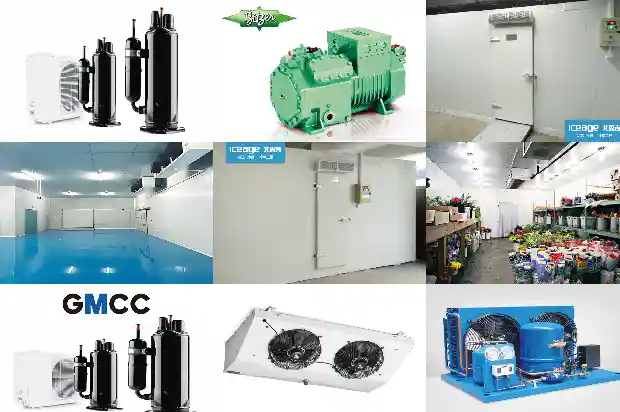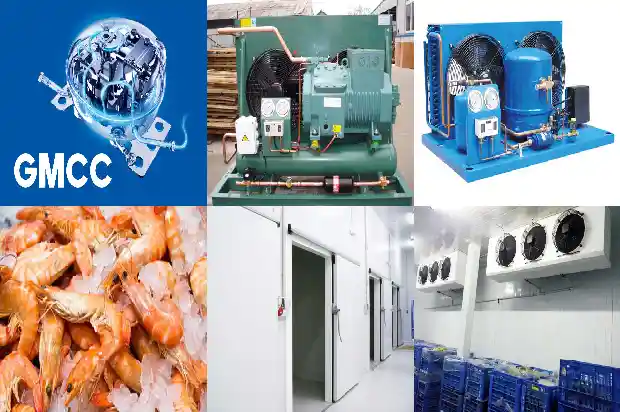Forms and Structures of Oil Separators in the Refrigeration System
2025-03-03
Currently, the commonly seen oil separators are of the following types: the washing type, the centrifugal type, the filtering type, and the packed type. Their structures and working principles are described as follows:
- Washing Type Oil Separator
The washing type oil separator is suitable for ammonia systems. Its main body is a cylinder made by rolling and welding steel plates, with a cylinder cover and a cylinder bottom pressed from steel plates welded at both ends. The steam inlet pipe extends from the center of the cylinder cover into the ammonia liquid at the lower part of the cylinder. A bottom plate is welded to the lower end of the steam inlet pipe, and air outlet holes are opened around the pipe end to prevent the high-pressure steam from directly impacting the cylinder bottom and agitating the precipitated lubricating oil to float up. In the middle of the steam inlet pipe in the cylinder (above the liquid level), there is also a balance hole on the pipe wall.
Its function is to balance the pressures among the exhaust pipeline, the oil separator, and the condenser when the compressor stops. Especially when an accident occurs to the compressor, it can prevent the ammonia liquid in the oil separator from being pushed back to the compressor by the high pressure of the condenser, causing a more serious accident. A porous umbrella-shaped baffle is also installed on the upper part of the outer side of the steam inlet pipe for separating liquid droplets. A drain pipe joint is provided on the side of the lower part of the cylinder body, which is connected to the oil collector. An air outlet pipe joint is provided on the side of the cylinder body above the umbrella-shaped baffle, and the steam outlet pipe extends into the cylinder for a certain length, and the outlet is opened upward. The purpose is to make the ammonia steam deflect once more before being discharged from the separator, which helps to improve the separation effect.
When the washing type oil separator is working, it mainly uses the washing and cooling of the mixed gas in the ammonia liquid to separate the oil. At the same time, it also uses the separation effect of the natural sedimentation of oil droplets by reducing the gas flow velocity and changing the gas flow direction. Among them, the washing and cooling effects have the greatest impact on the oil separation efficiency of the washing type oil separator. Therefore, a certain height of ammonia liquid must be maintained in the cylinder body. The ammonia liquid in the washing type oil separator is generally supplied by the condenser. In order to ensure that there is enough height of ammonia liquid in the oil separator, its liquid inlet pipe should be 240 to 250mm lower than the liquid outlet of the condenser. In addition, it is generally installed outside the machine room, close to the condenser, so that multiple compressors can share one oil separator. - Packed Type Oil Separator
In the packed type oil separator, a packing layer is installed in the cylinder body made by rolling and welding steel plates.
The packing layer is fixed by two porous steel plates above and below. The packing can be ceramic cups, metal shavings, or metal wire mesh, and the metal wire mesh has the best effect. When the refrigerant vapor with oil enters the cylinder body and the flow velocity is reduced, it first passes through the packing to adsorb the oil mist, then flows down along the wall of the cylinder in the expanding direction of the umbrella-shaped plate, and then changes the flow direction and returns to the top cavity through the central pipe for discharge. The separated oil accumulates at the bottom of it and is then discharged back to the compressor crankcase through the float valve or the manual valve.
The oil separation of this kind of oil separator is achieved by reducing the flow velocity, the adsorption of the packing, and changing the gas flow direction, among which the adsorption effect of the packing layer is the main one. Compared with the washing type oil separator, the packed type oil separator has a higher oil separation efficiency, which can reach 95% (the washing type is 80 to 85%). Its installation position is more compact, and there are no strict requirements for the installation position and installation height. Multiple compressors can share one oil separator. Therefore, the packed type oil separator is now widely used in ammonia refrigeration systems. However, the packed type oil separator has a relatively large resistance to the gas flow, and it is required that the flow velocity of the refrigerant vapor in the cylinder is not greater than 0.5m/s. In addition, the metal wire mesh of the packed type oil separator generally uses stainless steel wire mesh, which is relatively expensive. - Centrifugal Type Oil Separator
The centrifugal type oil separator has a better oil separation effect and is suitable for large-scale refrigeration systems. The exhaust gas of the compressor enters the cylinder tangentially along the inlet pipe of the oil separator, and then rotates at a high speed along the spiral guide vanes and flows downward. By the action of centrifugal force, the oil droplets with a relatively large density in the exhaust gas are thrown onto the cylinder wall and separated, flowing down along the wall and accumulating at the bottom of the cylinder. The vapor is led out through the porous plate in the air outlet pipe at the center of the cylinder body. A float valve is installed on the side of the cylinder. When the oil level rises to the upper limit position, the lubricating oil opens the valve core through the float valve and automatically discharges the oil to the compressor crankcase or the oil collector. Some oil separators are also equipped with a cooling water jacket on the outside, so that the mixed gas is further cooled by the cooling water and further separated through the effects of reducing the flow velocity and changing the flow direction. - Filtering Type Oil Separator
The filtering type oil separator is used in the Freon refrigeration system and is often called the Freon oil separator. When the high-pressure refrigerant gas discharged by the compressor enters the separator, due to the relatively large flow cross-section, the gas flow velocity suddenly decreases and changes direction. Coupled with the filtering effect of several layers of metal wire mesh during the gas inlet, the lubricating oil mixed in the gaseous refrigerant is separated and drips down and accumulates at the bottom of the container. When the accumulated amount of lubricating oil reaches a certain height, it returns to the compressor crankcase through the automatic oil return valve. During normal operation, due to the intermittent operation of the float valve, the oil return pipe is sometimes hot and sometimes cold. The pipe is hot when the oil is returned, and the pipe is cold when the oil is not returned. If the oil return pipe is always cold or always hot, it indicates that the float valve has failed and must be overhauled. During the overhaul, the manual oil return valve can be used for oil return. This kind of oil separator has a simple structure, is easy to manufacture, and is widely applied, but its oil separation effect is not as good as that of the packed type.
Related Articles
- Forms of Oil Separators
- Reasons for Compressor Oil Deterioration and Oil - adding Operations
- Oil Cooling Methods and Oil - changing Operation Procedures for Screw Compressors
- Causes and Solutions of Ice Blockage, Dirt Blockage and Oil Blockage
- Which is Better for Cold Storage: Cooling Coils or Air Coolers?
- Has Your Refrigeration System Experienced "Oil Carry - over"?
- Causes and Prevention of "Primary Condensation" and "Secondary Condensation" in Fan - Coil Units
- Common Faults of HVAC Fan Coil Units
- Introduction to Oil Collector in Refrigeration System
- How to troubleshoot dirty blockage, ice blockage and oil blockage in refrigeration systems?
- Installation and Oil Return Precautions for Refrigeration Equipment Pipelines
- Precautions for Replacing Refrigeration Compressor Refrigerant Oil
- What are the reasons for the poor oil return of screw compressors?
- Freezing Chamber System Blockage, Dirty Blockage, and Oil Blockage Characteristics and Treatment Methods
- Oil Cooling Methods and Oil Leakage Operations for Screw Compressors
- Five Common Problems in the Refrigeration System~~ Solve Them One by One!
- Pipelines Used in the Refrigeration System
- Does a lower evaporation temperature result in a larger refrigeration capacity, or does a higher evaporation temperature lead to a larger refrigeration capacity?
